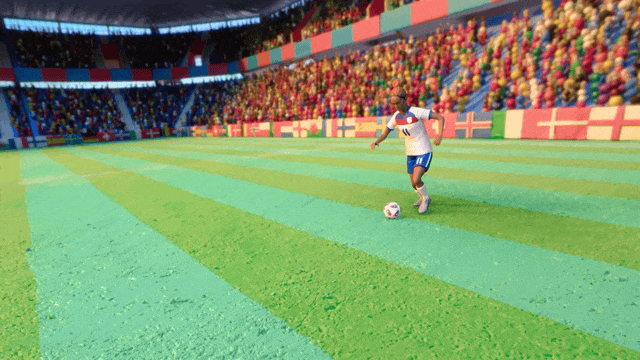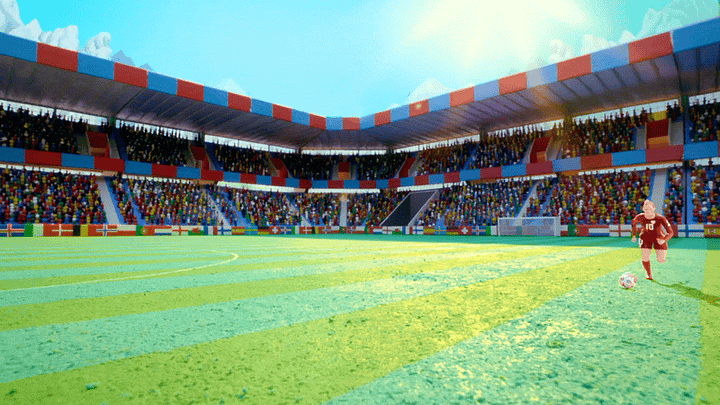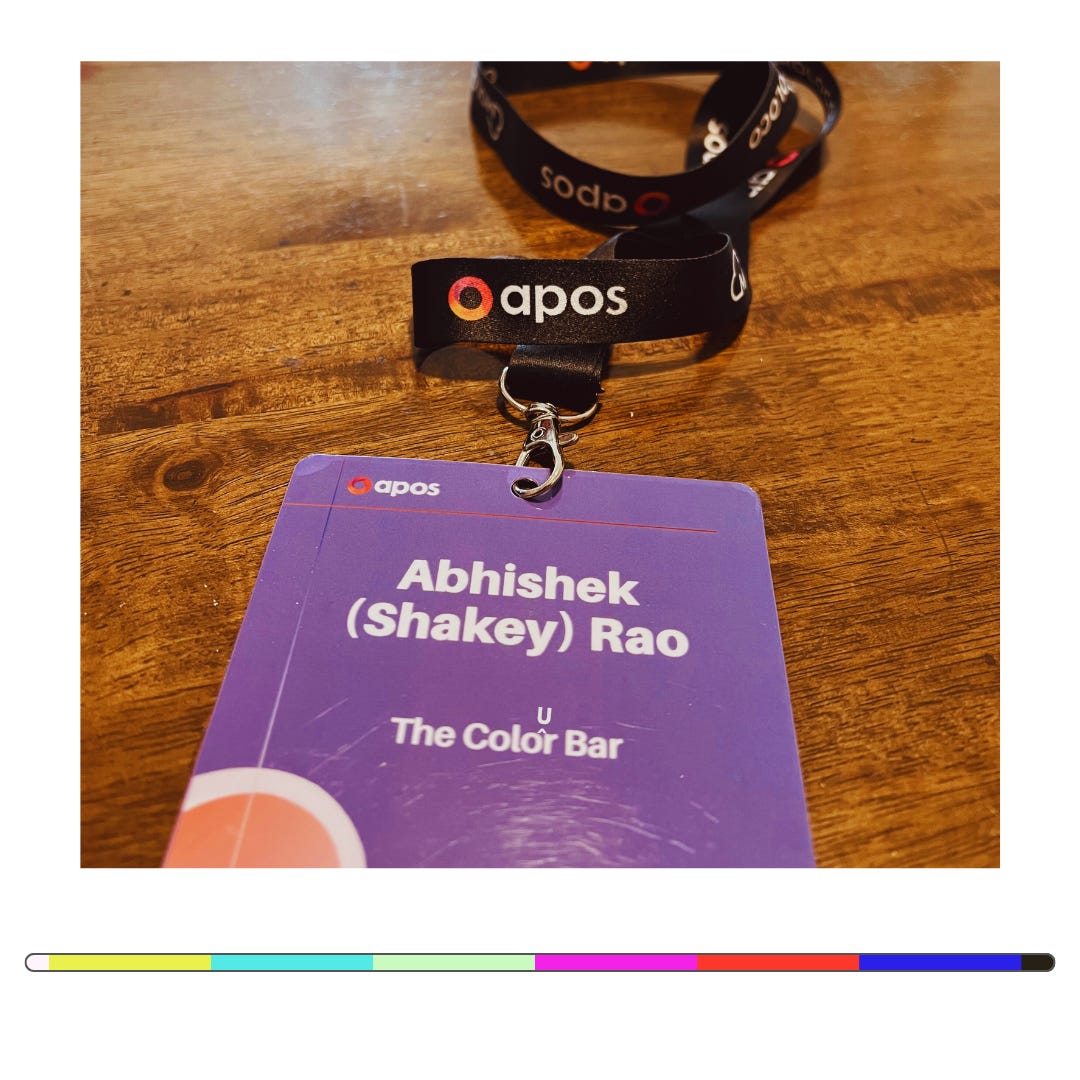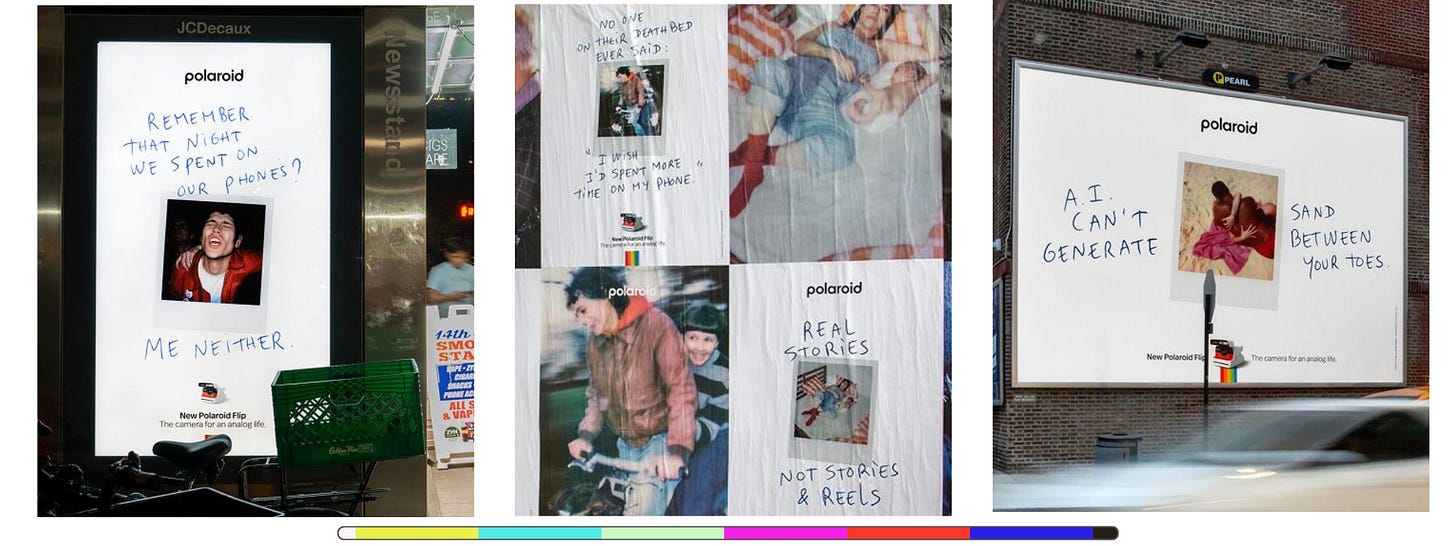Islands, insights, influence
· Glory in clay · APOS files · Analog charm · Influence & balance · Fake videos, real money ·
You can listen to this post by clicking on the link above.
Selamat siang!* I’m back- with perspectives that raise questions, offer some answers, and plenty to chew on.
Chomp chomp.
I have my first wrap from APOS, the APAC media and telco summit in Bali, and so much else.
Today’s ▶️ Curated/Cuts serves up eye candy as always- a gorgeously handcrafted claymation spot from the BBC; a charming human campaign from Polaroid; a fear-laced oddity from South Africa.
In entertainment: Netflix goes to space, Amazon MGM shakes & stirs Bond plans, and Tiktok & Insta roll up their sleeves for our TV screens. Plus, a thought-provoking look at India’s creator economy.
AI, as ever, isn’t far: two key rulings (Meta and Anthropic win…sort of); a bold Danish law to protect physical identity, shady AI-generated content on the Diddy trial making real money- and someone who thinks that’s cool. Also, if you couldn’t define slop… now you can.
This is the Colour Bar- where creativity, content, culture, tech, brands & humanity collide.
* ’Good day’ in Bahasa Indonesia
The Bali Files
APOS, as always, was not short on insight and perspective, with bold claims and powerful narratives being shaped for all in attendance. This year, I felt a clearer acceptance of the shifting sands beneath our feet, than I have heard/seen before.
Global players tom-tom’ed a consistent faith in Asia’s future as a global flag-bearer in technology adoption and storytelling; coupled with a deeper belief from regional players in rooted, local stories powering the road ahead. Neither of these are new themes, but both seemed to have gained momentum.
There was also a dynamic between scale, growth and convergence that was hard to pin down. Some players are eyeing powerful, wide-reaching growth; others looking to reimagine their business with invention, collaboration and technology (read: AI?).
"The bar is higher. Every dollar will be harder to win. We are entering a tougher, more competitive monetisation phase where growth must be earned.” This, from Vivek Couto, Exec Director of Media Partners Asia, was a key message in his opening lay-of-the land presentation. It set the tone- no waffling.
His data-packed session covered much ground, looking ahead through to 2030. MPA expects advertising to power this next phase. Scale unsurprisingly belongs to China, Japan, India- projected to rake in 74% of APAC revenues- though “their DNA is distinct, monetisation models differ dramatically.” China’s mature premium VOD is accompanied by short videos and now micro dramas, all on an engine of ads and digital transactions. Japan’s premium, TV-centric industry stays steady with high ARPU in SVOD and growing AVOD. India is all about dual engine of ads and value-conscious subscription across streaming and TV with mobile, local OTT, and hybrid models scaling simultaneously.
Growth might well belong to India and Indonesia, with the latter’s primary source of revenue being Social Video.
Asia-Pacific leads the world in screens, time spent, and innovation, but the message was clear- the path ahead is not just about scale, but convergence. How can (and who can) bring together social video/ UGC, premium VOD, AVOD and AI to reframe the journey? Both platforms and media powerhouses staked their ambitions, though the question was not answered in Bali.
Other themes I will look at in the coming dispatches are AI (because, of course), local content (because, we must), and micro dramas (because, everyone says so).
· 🎬 Curated/Cuts ·
1. Names will be made: UEFA Women’s Euros


This trailer for the BBC uses claymation made “the old fashioned way” (i.e with humans). Action-packed and vibrant, here is a spot you can feel people have really ‘hand-crafted, with love’- there is no other way such gorgeousness happens.
Directed by Nicos Livesey, made entirely from clay · Blinkink - the team behind the brilliant Britbox commercial some time ago. · Steven Lownes for BBC · (Full Credits )
2. Analog lives: Polaroid
Charming campaign from Polaroid came by last week. Nicely done, leaning into the ‘real’ positioning they have had for some time now, while neatly prodding AI and phones as well. Sample these OOH examples.
Also, I think I am a bit of a instant photo sucker- have always been drawn to them and it is unsurprising this campaign (and scrolling through their IG) makes me want to go out and buy one right now!
Done by the in-house creative team · CD Patricia Varella ·
3. Bites of Soul: from South Africa
Fear brings out the best worst whackiest in us. Sample this from South Africa, unless you have a mortal fear of bones.
· Entertainment ·
Tik, tok, TV.
“Living rooms are the new front line for us”
Tiktok & Insta want to be on our TVs. That quote is from the head of TikTok’s global product division, David Kaufman, at the Cannes ad festival. But wait- the world has become vertical, right? Landscape is passe, right? And so inauthentic? I’m so confused, please platforms, help me out here.
Just kidding. Ok, partly.
At any rate, we do hear how both platforms are gently prodding creators toward longer uploads and horizontal videos. The product challenge is to merge the two experiences in a way that the essential ethos of Tiktoks or reels or even IG posts, is not lost in a drive for landscape videos for TV. Essentially, not becoming Youtube on TV, but a new experience true to themselves.
Hernan Lopez/ Streamonomics has some astute points made here.
Netflix in space
Ok, not quite. In a new partnership, NASA’ streaming videos will be available on Netflix. You may not have known it, but NASA has its own streaming app. NASA Plus includes “rocket launches, astronaut spacewalks, mission coverage, and breathtaking live views of Earth from the International Space Station.” You’ll still need to sign up with NASA, but its free, and will plonk the other-worldly content right there alongside your true crime series or slightly dodgy reality show. It’s also non exclusive so you can continue to see it on NASA’s own platforms. The deal may not be out of this world (except when its literally off-planet), but it sure adds a cool layer to the carousel.
James D Bond
Amazon MGM’s announcement that they’ve snared Denis Villeneuve for the Bond franchise is definitely big. You can’t know what might come of this, yet I struggle to see how this is not a super win for Amazon at this point.
They bury the chaos around the change of hands with IP ownership, when they took sole ownership from the Broccolli family. Many worried it would spell the beginning of the end for the suave British spy.
Here’s a respected filmmaker known for vision, craft and spectacle. Who just happens to be coming off a brilliant adaptation of beloved material himself (Dune).
Hitting the right notes in the release. Words like ‘sacred’ reiterate his and the studio’s desire to do justice to a long standing IP, one that definitely ran (runs?) the risk of being upended by calls for reinvention.
Any which way, it’s Denis V. I’ll be there for it.
Influence and Balance
The Creator Economy! Barely a week goes by without hearing about it. How it is the entertainment economy, how it has disrupted consumption, attention, commerce. Or how rapidly the creator economy itself is changing; toward media models like studios and ‘independent TV’, some insist.
Much of this depends on the geography we speak of. Creators, their access and unbridled expression are in most corners of the globe (if the globe had corners). Yet, the stages of development, maturity, monetisation and scale are not uniform. In India- in many ways Youtube’s largest market- the creator ecosystem is vibrant and enormous.
Across India, a cultural pivot is underway- visible in the millions of GenZ youth choosing the creator economy as their principal ambition. Armed with smartphones, self-certified aesthetic intuition, and fuelled by platforms that promise global reach at the tap of a filter, they are abandoning traditional career pathways in favour of an identity economy shaped by attention, relatability, and social capital.
Yet if some of these arcs are common across continents, some concerns are similar as well- too few creators ‘make it’, the allure of a career with no safety net, a gap between metrics of the ecosystem and actual income, underage questions, challenges in advertising, lack of regulation.
According to the Advertising Standards Council of India’s recent Influencer Compliance Scorecard, “over two-thirds of India’s top 100 digital creators failed to adhere to even the most basic disclosure norms in their brand partnerships.”
Some argue that the creator economy is broken, or not fulfilling its promise. Others counter it is doing exactly what it was meant to, just not what we hoped it to- maximising engagement on platforms, farming attention, raking in the ad dollars. Individuals helping scoop up all those eyeballs are merely cogs in that machine, collateral damage to algorithm changes.
“A civilisation must find its strength in purpose, not just in popularity. Can a generation survive on the hope that a viral moment might translate into monetary security? “
The mirage of influence, by Srinath Sridharan.
AI
First off, the Cambridge dictionary has decided to add a new definition for the word ‘slop’, courtesy- you guessed it- AI. ‘AI slop’ is a term that now denotes poor quality output coming from AI, and has become widely used since some time last year. ‘Slop’ now includes this definition, “content on the internet that is of very low quality, especially when it is created by artificial intelligence.”
You own your look.
This bit would sound satirical except it is entirely accurate, relevant and required:
Here’s a radical notion- we own our own physical identities! The Danish government is looking to blot out the creation and spread of AI-generated deepfakes. Their freshly amended copyright law states everybody has the right to their own body, facial features and voice. You’d think we did, right? The Danish culture minister said he hoped the bill before parliament would send an “unequivocal message” that everybody had the right to the way they looked and sounded. Go on then, own it.
Fake videos, real money.
Diddy content generated with AI have been raking in the views (and dollars) as the rapper’s trial has gone on.
“If you would say, ‘Hey, how can I make $50,000 as soon as possible?’ Number one would be like doing f**king drug [dealing], but number two would probably be to start a Diddy channel.”
This, from one Waaner Aarts, someone who runs dozens of Youtube channels with AI-generated content. The general thinking among the YouTube ‘faceless/automation community’ is that anyone who can figure out a way to make money deserves respect, he claims. “I have nothing to say other than congratulations to those people that are able to pull something like it off.”
Where’s a good head shaking emoji when you need one.
AI boosts in court.
Anthropic scored a significant win in an AI lawsuit as a judge ruled that the company’s use of books without permission to train its artificial intelligence system was legal under U.S. copyright law. He did also rule, though, that Anthropic's copying and storage of more than 7 million pirated books in a "central library" infringed the authors' copyrights; they could face billions in damages for that.
Meta got a similar boost and ruling on use of copyrighted books. The judge made it quite clear though that he did not believe such cases would have the same outcome if authors took a different approach. Notably, “This ruling does not stand for the proposition that Meta’s use of copyrighted materials to train its language models is lawful. It stands only for the proposition that these plaintiffs made the wrong arguments and failed to develop a record in support of the right one.
”The judge dismissed as “nonsense” Meta’s claim that the public interest would be “badly disserved” if tech companies were not protected from scraping copyrighted material to train large language models.
APOS- Say What?
Rounding things off with a smattering of quotable quotes from the summit.
“The region is going to lead the world. We have been getting trends, now we will lead.” _Aditya Swamy, Google APAC
“Don’t look at many fans as one, look to serve one as many”
_Sanjog Gupta, Jiostar
“Today tech is at the centre of the world but tech is not immune to the shifts we face.“ _Virginie Maisonneuve, Allianz Global
“Friction of great minds brings about great art. “
_HB Naveen, Falcon Pictures
“AI alone isn’t ready. Human insight isn’t enough either.“
_Monica Landers, Founder & consultant
“There’s a misperception that somehow social video and TikTok’s are more authentic than premium video to culture. This is not true.”
_Helen McRae, WPP Media
“Sports, we call it like a drug addition- its nice when you have it but its expensive and you have it for some time, and then you are addicted”
_Sutanto Hartono, Emtek & Vidio
“We aren’t trying to court people’s attention, we are courting people’s emotion.”
_Sushant Sreeram, Jiostar
“Better is better, not more is better.“
_James Gibbons, Warner Bros Discovery
This week, that year: Back in 1941, the Bulova Watch Company paid $9 for the first-ever television commercial. It aired during a baseball game- the broadcast of Brooklyn Dodgers vs Philadelphia Phillies.





